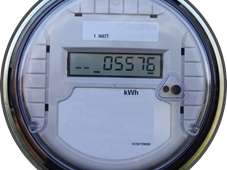High Performance Switches for Modern Utility Meters
By Mike Bolduc | April 03, 2017

Energy meters have taken many different forms since they were first created for widespread commercial use in the 1880s – electric energy meters, similar to traditional gas meters, were required to bill customers for the cost of energy, instead of billing for a fixed number of lamps per month. Early types of electrochemical meters that were used in the UK consisted of a vertically mounted glass structure with a mercury reservoir at the top of the meter.
Modern day energy meters can display the energy used on an LCD or LED screen, and some can also transmit readings to remote places. They can also support time-of-day billing, record the amount of energy used during on-peak and off-peak hours and advise the end customer the best (translated “cheapest”) time of day to do the laundry or run the dishwasher.
No matter what form, shape, size, or embedded technology, energy meters have been developed since the beginning to withstand two threats to their security and basic operation: tampering and harsh environments. Fortunately, there exists a plethora of powerful switches that are helping defend today’s modern energy meters from these hazards.
Because energy meters are typically placed outdoors and can’t be visually monitored by the utility, they can easily be tampered with by users who want to get free electricity. Detect and snap switches make it harder for people to tamper with the meter’s internal electronics by sending a signal to the utility in the event the meter’s cover is pulled off.
Outdoor energy meters also must endure harsh environmental conditions, such as wide temperature ranges, rain, snow, salt, and humidity that can corrode the contacts and lead to failure.
The switches specified for use on these meters – ranging from the detect and snap devices used for tamper prevention to the tact switches used to activate and navigate the displays – must be rugged and reliable enough to withstand these conditions for many years.
Today’s energy meters are also getting smarter, thanks in large part to the Internet of Things (IoT).
Modern smart meters now have the ability to monitor energy usage, communicate cost information to the end customer via a display screen, as well as shut off the service remotely for lack of payment. The tact switches used to actuate and navigate the display need to be small, rugged, and reliable – capable of withstanding challenging environmental conditions as well as offering mechanical layout flexibility to design engineers. Switches with customizable haptics – the sound and feel when the switch is pressed – also communicate an image of quality to the end customer.
Relative to security and meter tampering, it’s helpful to have a wide variety of switches to choose from. Suppliers with a large portfolio of standard detect, snap, and tact detect switches give designers flexibility in accommodating different mechanical layouts. As the tamper switches used in modern communicating meters are typically operated in the normally closed position, it’s also important that they operate effectively with minimal current levels in order to keep energy consumption to a minimum.
In addition to the typical electromechanical switch, many modern smart meters also incorporate SIM card sockets for use with an internal modem which can communicate usage and billing information between the utility and remote locations. SIM cards can also serve the dual purpose of accepting payment cards for pre-paid, or pay as you go, meters.
Whether your energy meter is stuck in 1888, or comes equipped with the digital bells and whistles today’s IoT has to offer, the proper switches to activate these meters are needed to ensure the smooth flow of energy to home owners, business occupancy and beyond.
View C&K's portfolio of utility meters' switches

Mike Bolduc
Global Segment Manager
Industrial & Medical
